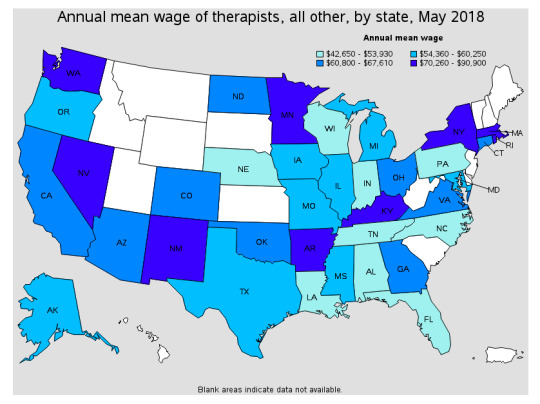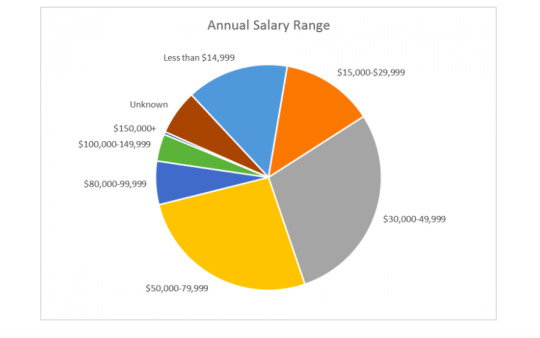Text
Art Therapy and its Career Outlook
Art therapists are required to do a plethora of duties that are dedicated to helping the wellbeing of others through creative means. We will look into the education and training required to make licensing possible for aspiring art therapists. Additionally, this article will explore the hardships that come along while in the process of becoming an art therapist and what the career outlook looks like for the profession.
What kind of education and training is needed? What challenges do aspiring art therapists face?
As a requirement, those pursing art therapy must obtain their Bachelor’s degree in art or psychology, and the American Art Therapy Association (AATA) advises to get a Master’s degree in art therapy or counseling for an entry-level job in art therapy. In addition, the AATA requires students to complete a minimum of 100 hours of direct supervision in art therapy practice and 600 hours in a supervised art therapy internship while in a graduate program. However, graduate students have difficulty finding programs that are in line with art therapy practices and counseling.
After completing a program and the hours required, licensing is the next step toward becoming an art therapist and/or creating an art therapy practice. However, licensing varies across the United States.
Art therapist and psychologist, Cathy Malchiodi, explains how art therapy programs have changed. Programs have become modified in order to put graduates on a track to become licensed in counseling instead of art therapy. This is due to the lack of art therapy licenses available nationwide.
Although many states across the U.S. do not provide licenses for those pursuing art therapy, it is still a requirement to be licensed in order to formally practice art therapy and for independent practices to be considered legitimate. Because of this, many aspiring art therapists end up becoming social workers, licensed counselors, or psychologists in order to easily be able to practice art therapy.
In an art therapy podcast by Thirsty For Art, Yoong Jung describes her own experience on the path to becoming an art therapist and a trend she noticed about art therapy master’s programs. She noticed art therapy programs were changed and renamed along the lines of “Master’s in counseling with a specialization in art,” and she hypothesized that programs were doing this in order to increase graduates’ chances of finding a job in the mental health field and be able to apply for different mental health licenses, such as for social work licenses and therapy. It seems that these universities are modifying their art therapy programs in order to create a safety net for their graduates and provide them more opportunities. These programs have been modified in order to expand graduates’ opportunities on finding a job across the mental health field. In spite of programs that allow specialization in creative expression, it does not guarantee a higher demand for art therapists or an increase in art therapy job opportunities.
The figure below demonstrates which states offer licenses, those that are seeking to provide licenses, and those do not provide licenses for art therapists. The states in gray do not offer art therapy licenses; the states in violet recognize art therapy as their own profession but do not provide licensing; the states in blue-green allow those pursuing art therapy to become licensed under a different but related license; the states in blue are trying to advocate for an art therapy license; the states in green offer an art therapy license. If you are pursuing art therapy or any other field, It is important to recognize where you live and what your state offers in regard to that profession.

Due to the lack of licensing in some states and limited art therapy programs, it is difficult for aspiring art therapists to fully become practicing art therapists under an official title. These challenges impact who is able to enter into the art therapy profession.
Demographic of art therapy members?
Art therapist, Sarah Greenall, gives insight to her observations from with the art therapy field and explains how art therapy settings and practices lack diversity through her examination of two surveys conducted. These surveys shed light onto attitudes and perceptions held about the art therapy profession. Respondents from the two surveys were art therapists or in a different profession within the mental health field, and they reported that they assumed that most art therapists were women and regarded art therapy to be connected to female gender roles. Additionally, she explained how these perceptions about the art therapy field may influence the people’s decision of entering the field. Perceptions of those within the art therapy field may influence the demographics of the profession and what art therapy settings look like.
A 2011 membership survey report also highlights the lack of diversity present within the art therapy field. Additionally, Sara P. Deaver, a director of Eastern Virginia Medical Schools’ art therapy program, and David E. Elkins, a research associate, noted that the vast majority of art therapists were caucasian, female, and held a master’s degree. Assumptions and perceptions about gender influences who enters into the career, which impacts the career outlook for art therapy in the long run. The perceptions of who enters the profession influences people’s choice of selecting art therapy as a career path, especially for those who do not identify as white women. Perceptions may have an influence the overall demographics of art therapy.
Expected salary for art therapist?
The salaries of art therapists greatly influenced by the amount of experience an art therapist holds and the location of where they practiceBut according to an article for the U.S. Bureau of Labor Statistics, they consider art therapists as recreational therapists in order to estimate their salary. In populated areas, recreational therapists earned a higher salary than those in less populated areas.
The figure shown below illustrates the annual mean wages of therapist by state. The darkest areas have the highest annual mean wage (~$70,260-$90,900), whereas the lighter areas are much lower (~$42,650-$53,930). The areas in white do not have any data about the mean wages of therapists. Whether you are interested in pursuing art therapy or another career, you need to consider where you live when making decisions about entering the field.

In a 2016 membership survey from the American Art Therapy Association, about 28% reported salary ranges from $30,000-$49,999 and another 26% of the respondents reported that their salary ranged from $50,000-$79,999. It seems that the majority of art therapists have a salary that ranges between $30,000 and $80,000. However, due to low salaries in some areas of the U.S., it has deterred some art therapists from the art therapist field, and many have turned to other professions in the mental health field or creating their own art therapy practice.
The figure below illustrates the annual salary range based on the membership survey of 2016.

Salary is a factor that impacts the career outlook in different areas. It influences who enters the profession and where in the United States they enter into the art therapy field.
What is the career outlook of art therapy?
The education and training required, assumptions about the art therapy field, challenges regarding licensing and art therapy programs, and the expected salary all influence people’s career choices in becoming art therapists and who is able to enter into art therapy. It is essential to consider these challenges and requirements when investigating a specific career and considering the career outlook, especially in the art therapy field.
Overall, it seems that the career outlook for art therapy may be tough in the sense it is difficult to find a job under art therapy in areas that are not densely populated. However, there are mental health related job opportunities available where you can apply your passion for art and helping others to that field. There is a possibility that the future will see a big increase in art therapy jobs and create more recognition for the art therapy profession.
However, If you truly want to be an art therapist, you can always always use your art in service to others, whether it is through an actual art therapy practice or alternative paths. Whether you pursue art therapy or similar careers, you cannot forget that art can change lives for the better, and it is still a worthwhile journey to study art therapy. Even though there may not be many jobs under art therapy, there are still jobs out there where one could apply the knowledge and skills that they gained through these programs to another job. However uncertain the future may seem, you should never be discouraged from pursuing your passions. There will always be opportunities available, even in the face of hardship.
0 notes